
Whether you want to see its valleys in autumn, cross its hard ski slopes in winter or take a walk in spring and summer, the Pyrenees mountains of Huesca are a perfect destination for a getaway. With deep forests, Romanesque everywhere and dreamy beech forests, many of its towns are as isolated as they are charming. With this route through the most beautiful villages of the Aragonese Pyrenees you can discover all the beauty that this remote area of Spain has to offer. A two-day route that is ideal for a bridge and has many possibilities of expanding with nearby and complementary destinations. Here is where it all starts.
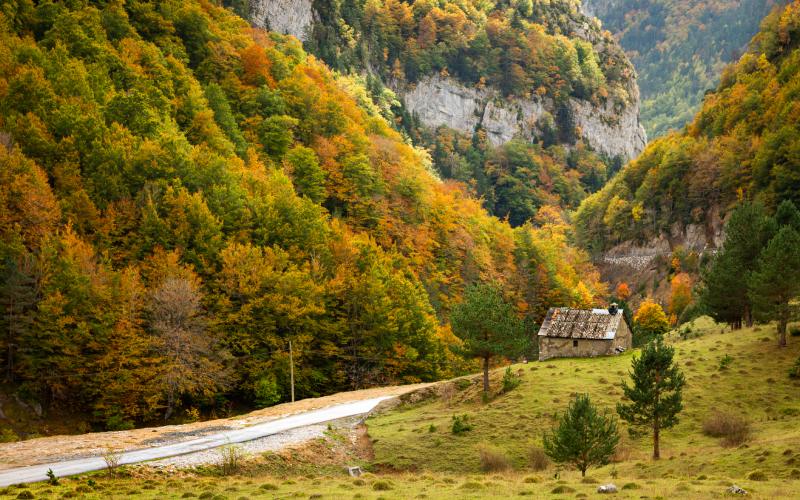
Ansó Valley. | Shutterstock
The first day goes from the surroundings of Navarre to the heart of the north of Huesca. A journey around the Valles Occidentales Natural Park. Its mountains, like the Bisaurín, provide the backdrop for this part of the route through the most beautiful villages of the Aragonese Pyrenees. Meanwhile, the most recognizable axis of the day will be the Aragon River. This river course gave its name to the historic county, when it was part of the Navarrese kingdom, and later crown.
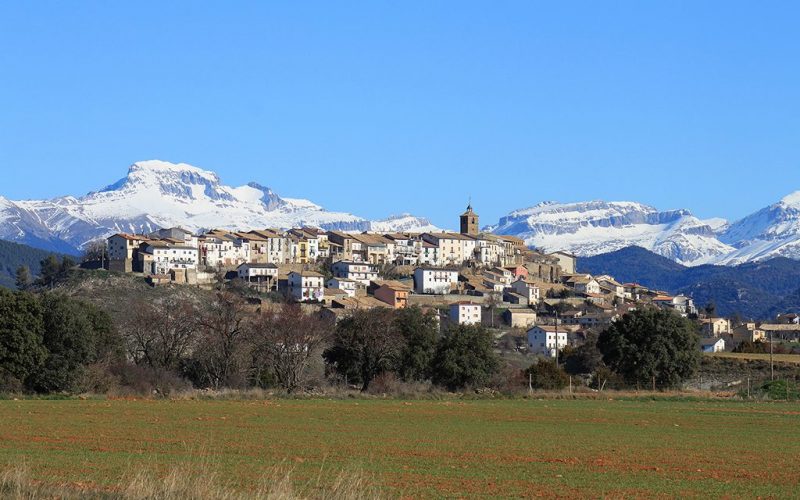
Berdún.
On the plateau of a hill and visible from any point of its surroundings, Berdún is the starting point. Areas of grass, some small trees and live rock are intermingled in its surroundings. Thus, the picture is very showy. Inside the village the church of Santa Eulalia and the Casa Lacadena stand out. Where the latter is located, there was a medieval castle. From here, taking advantage of the morning, it is time to take the A-1602 for half an hour to reach the next stop. On the way is the beautiful Biniés and its fortress.
A landmark in the foothills of the Valles Occidentales, this town is famous for its role in the Tribute of the Three Cows. This treaty is the oldest in force in Europe and consists of handing over a three head of cattle from the inhabitants of the French valley of Baretous to those of the Roncal, mainly Isaba. Ansó had the role of arbitrator and was the one who decided that this should be the compensation for the use of the pastures.
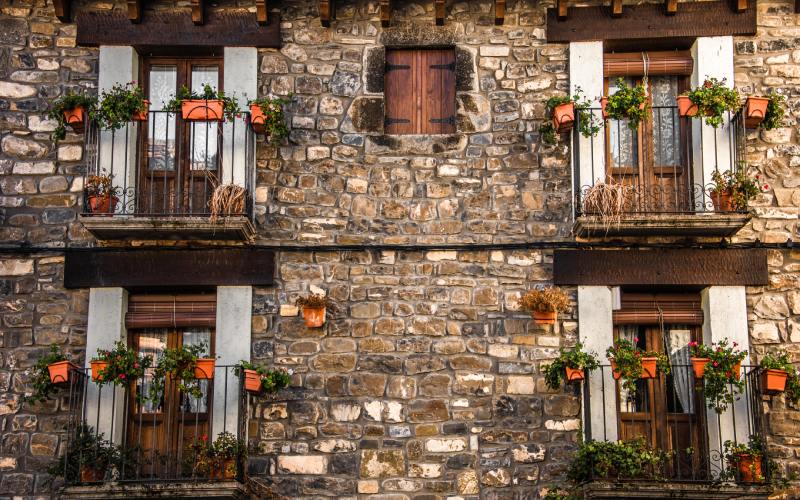
Typical Pyrenean architecture in Ansó. | Shutterstock
The local culture survives strongly in Ansó. It is the main centre of Ansó language, a variant of Aragonese. It extends through the aforementioned Biniés and the nearby Fago. They also have curious regional costumes that have attracted the attention of intellectuals like Pérez Galdós. Their history can be seen in several local museums. It is worth mentioning the presence of bears in the area. This and other elements can be discovered in an information center.
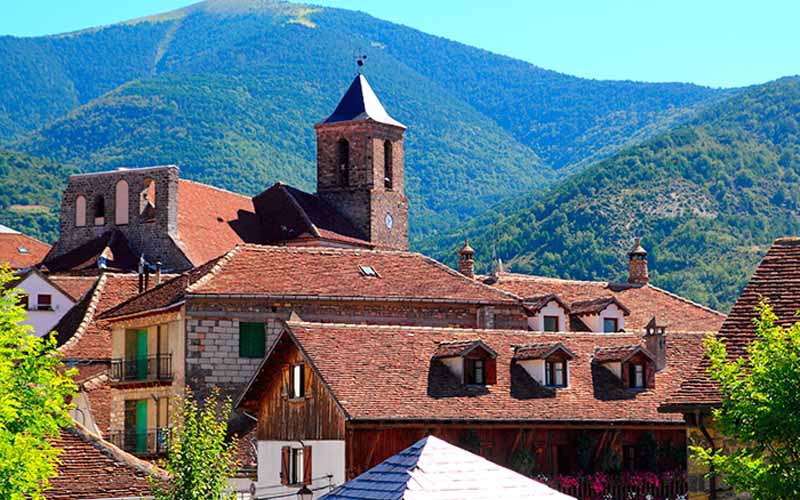
View of Hecho with the Church of San Martin.
As in the case of Ansó, in Hecho there are striking cultural elements to appreciate. For example, the Chaso, a dialect of Aragonese and the style in which its typical costumes are called. It also has a curious open-air sculpture museum. Its houses have popular elements such as the scarecrows that crown its chimneys. The megaliths in the area are the protagonists of a small museum less than ten kilometres from the village. However, what stands out most from its surroundings is the Aragonese monastery of San Pedro de Siresa. Originating in the ninth century, it was very much linked to the history of Aragon, being the building where Alfonso I the Conqueror was educated.
Another half hour drive from Hecho leads to Santa Cruz de Serós. In between you can make a stop at Puente La Reina de Jaca. Like the town of Navarre, it is closely related to the Way to Santiago. Both have a bridge that pilgrims and other travellers cross. In the case of Huesca, people from the French Way through Aragon and in the case of Gares of the French Way through Roncesvalles.
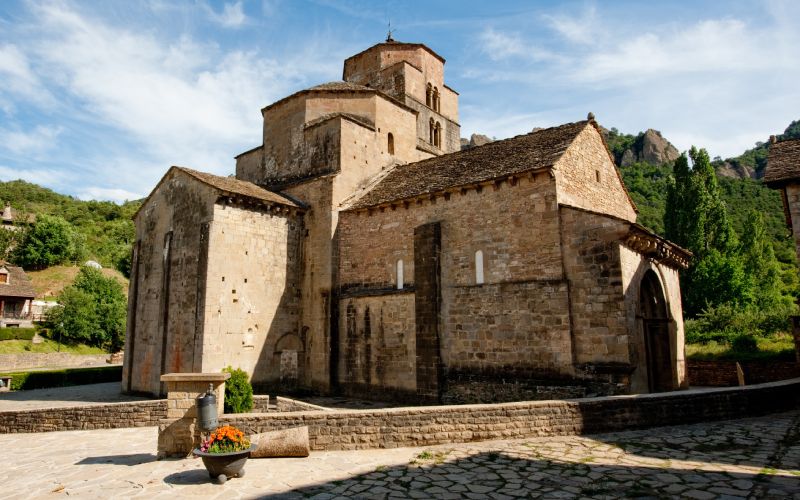
Church of Santa María in Santa Cruz de la Serós. | Shutterstock
Santa Cruz de la Serós has a typical and peaceful atmosphere, as well as the beautiful Romanesque church of Santa María, but it is not only for this reason that it stands out. Its great attraction awaits very near, after an attractive road of eight kilometers. This is the monastery of San Juan de la Peña. There rest several kings of Aragon, in one of the most famous pantheons of Spain.

Monastery of San Juan de la Peña (Huesca)
It has two buildings, one from the 11th-12th century and another from the 17th century, which complemented the first one after a fire. The location of the old one, under a huge rock, is one of the most impressive pictures of this route through the most beautiful villages of the Aragonese Pyrenees. A good idea is to arrange lunch in Santa Cruz de la Serós and visit the monastery after it, in the early afternoon.

Jaca Cathedral. | Wikimedia
The final destination of the day is also the most complete. Leaving the Valles Occidentales to the east, Jaca is a beautiful medieval town that fits in perfectly with the natural environment that surrounds it. It is the best end of the stage thanks to its delicious gastronomy and wide range of accommodation possibilities. Its cathedral is one of the great Romanesque jewels of the country. It is worth paying attention to other temples such as El Carmen or Santiago. The latter refers to the enormous Jacobean tradition of the population. On the other hand, the head of the Jacetania, a region that includes all the villages mentioned so far, has two extraordinary fortresses.

Citadel in Jaca
One is Rapitan’s fort. Totally defensive and prepared to unload and support artillery fire, this nineteenth-century work executed in stone still impresses today. However, the most special military work of the Pyrenean city is the Citadel of Jaca. Also known as St. Peter’s Castle, it is a star-shaped fort built in the last decade of the 16th century. With hardly any action, it has kept all its elements almost intact, making it unique in all of Europe. It also houses a collection of military miniatures with more than 30,000 pieces that recreate battles.

Train stations in Spain. Canfranc
If you miss any of the intermediate points, such as Ansó y Hecho or San Juan de la Peña, you can choose to visit Canfranc. Its train station, which is not used internationally, is one of the most beautiful in Spain. This great modernist landmark is the highlight of the border town of Huesca. Going along the paths of the Aragonese Way, there are 25 kilometres from Jaca. It is also worth stopping in the town, which has several interesting medieval elements. In any case, the recommendation is still to spend the night in Jaca, as this means saving half an hour on the second day, which is somewhat longer than the first.
From an intermediate point between the Valles Occidentales and the Ordesa and Monte Perdido National Park as is Jaca, you can reach the heart of the Escondido Valley, in the Posets Maladeta Natural Park. A slightly longer route than the first day, but which passes through places of extraordinary natural beauty. In addition, it leaves the door open to jump into the Ilerdense Pyrenees, with the Natural Park of Aigüestortes, in case you have some more days.
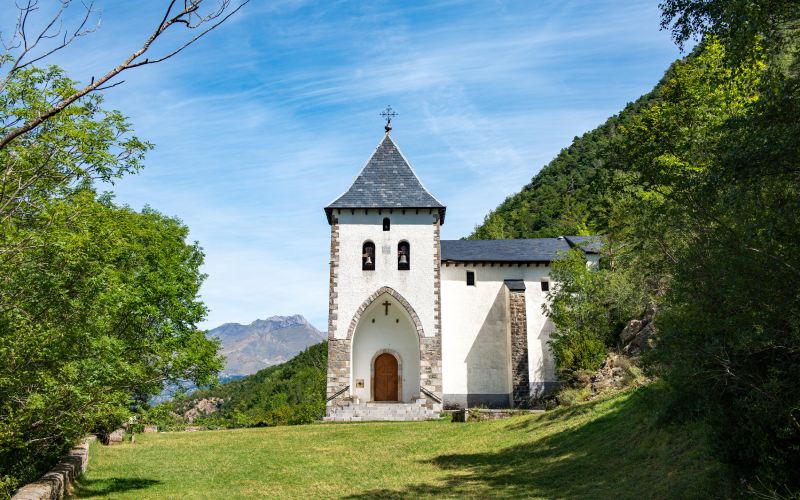
Hermitage of Santa Elena in Biescas. | Shutterstock
Part of the Tena Valley, when you arrive at this Aragonese town you find yourself in a glacial environment, reflected for example in the Ibón de Piedrafita. The Gállego river, which extends from the north and waters the valley, is the main river in the town. Its status as a stronghold can be seen in its houses, many of which have a markedly defensive character. Near the town is the fort of Santa Elena, from the time of Philip II. The church of San Salvador, dating from the beginning of the 13th century, is the most notable temple in Biescas next to the hermitage of Santa Elenea. Five kilometres from the centre, around it there are both Roman and megalithic remains.
Although it is only 25 kilometres to Torla from Biescas, the journey can take almost 40 minutes. In any case, it is worth it. One is at the western entrance to the Ordesa valley, a World Heritage Site. For this reason it is one of the unmissable points on this route through the most beautiful villages of the Aragonese Pyrenees. This also means that the most beautiful time of year is autumn.
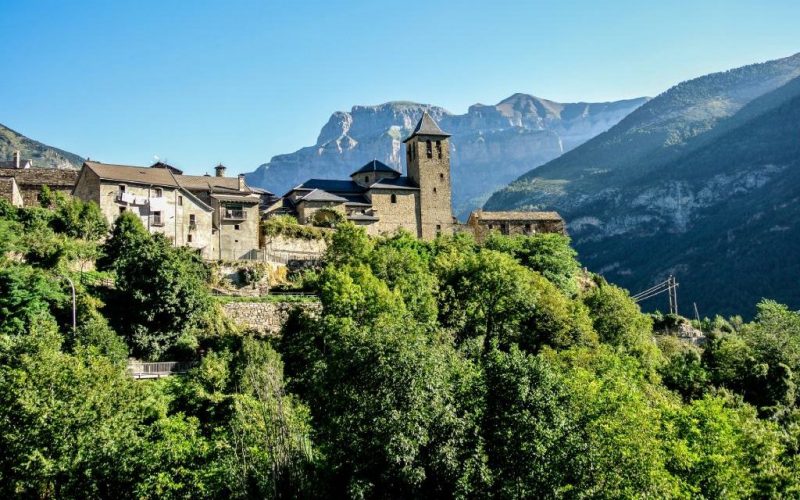
Torla.
There are hardly any remains of its old castle. This is due to the several assaults it suffered from the French, since it was one of the entry doors to the country through Huesca, next to Jaca. Where the Huesca fortress used to be, today there is a church, that of San Salvador. Its stamp is the most characteristic of the place, forceful. Its current work is due to the reforms of the sixteenth century.
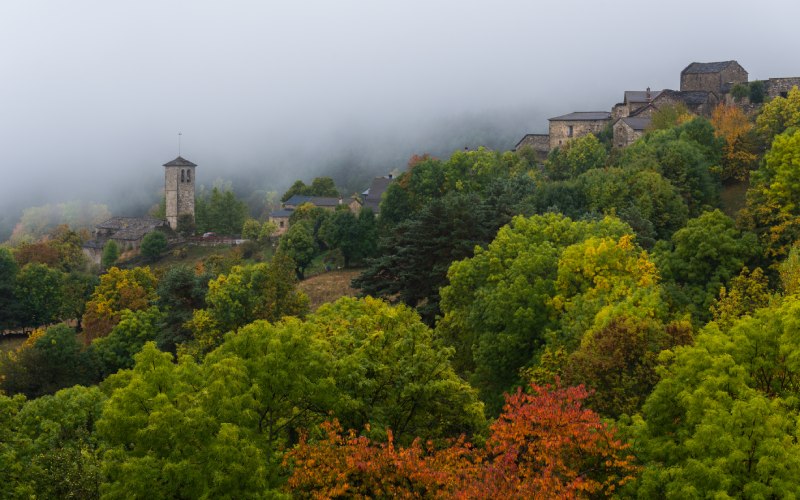
Foggy day at Fanlo. | Shutterstock
Following the perimeter of the Ordesa and Monte Perdido National Park, as well as the Pyrenean Glaciers Natural Monument, a little over eleven kilometers is Fanlo. On the way you should pay attention to the beautiful forest of Pardina del Señor. The traditional architecture is very similar to what can be seen in other villages on this Huesca route. Defined by dark stones, it leaves very attractive panoramic views. Its church and two houses with defensive towers deserve a special mention.
The HU-631 leaves great landscapes but must be taken with great caution. Together with the A-138, it leads the way to Aínsa, which is 34 kilometres long but takes one hour. Before connecting with the second road, you will cross the Añisclo Canyon. When entering it, it is worth stopping to enjoy the San Úrbez hermitage and bridge, as well as the Aso waterfall. Next to the Cinca and the Peña Montañesa it ends up in Aínsa.
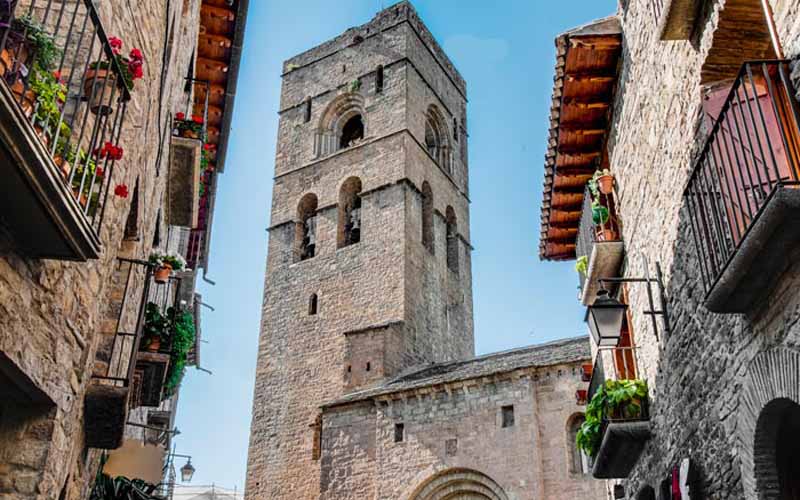
Church Tower and typical houses
It is also as good an option to eat in the Ainsetan town as Fanlo. In between there are bucolic villages like Belsierre, where you can also take advantage of the gastronomy of the Aragonese Pyrenees. The main factor in this choice is how early you get up and the time spent at each stop. Be that as it may, a visit to Ainsa is a must.
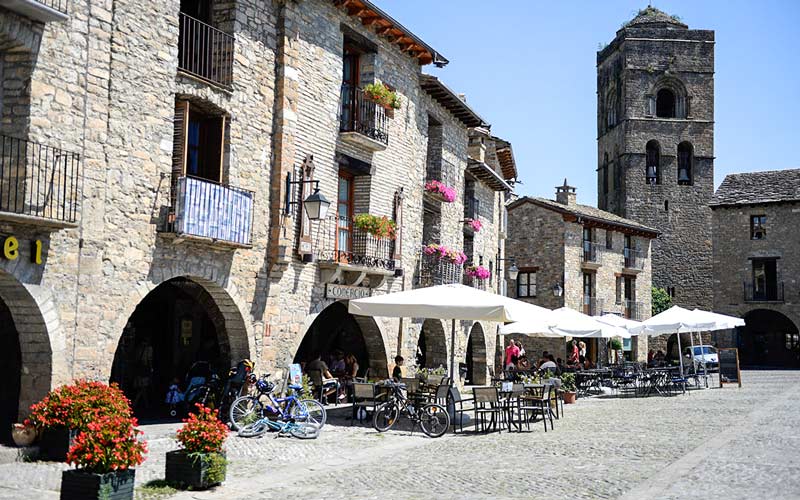
Plaza Mayor in Aínsa
It was one of the heads of the Sobrarbe County. The corresponding medieval county was one of the foundations of the Kingdom of Aragon and inspired part of the symbols associated with its crown. Although its historical capital is Boltaña, less than ten minutes away, at present the biggest centre of activity is in Aínsa. Its castle is the most outstanding heritage element. The church of Santa Maria and several large houses are also very interesting. However, the general appearance of the village, both stony and ochre, is what makes the place extraordinary. To the south awaits the beautiful Mediano reservoir, which swallowed a village when it was builtembalse de Mediano, que se tragó un pueblo al ser construido.

Benasque. | Shutterstock
The greatest journey of this route through the most beautiful villages of the Aragonese Pyrenees happens to reach the final point. Benasque is the most outstanding town in the Escondido Valley, a purely mountainous environment in the shadow of the Aneto and the Madaleta. Beyond its beautiful Romanesque church, the medieval bridge or the palace of the Counts of Ribagorza, the surrounding nature stands out. Lakes, very high peaks, dense forests, sinkholes like the Forau de Aigualluts… Enough elements to dedicate a getaway in itself in case you are a hiking and mountain lover. Its spa is also famous, with one of the most appreciated thermal waters in Spain.
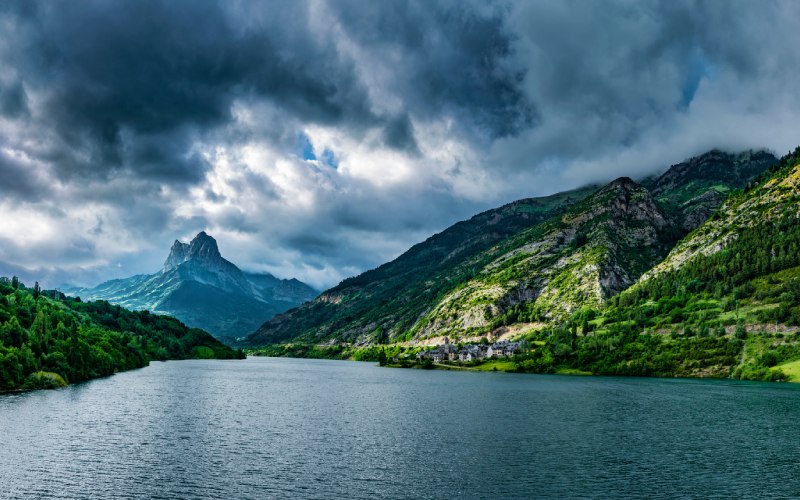
Sallent de Gállego y el embalse de Lanuza. | Shutterstock
With the immense crag of the Foratata and the Lanuza reservoir in the background, Sallent de Gállego is an idyllic-looking town. A perfect place for beginners or experienced hikers. It has a charming gothic church and Formigal with its ski resort is located nearby. A place that is not necessarily on this route through the most beautiful villages of the Aragonese Pyrenees because it is somewhat out of the way. You have to travel 20 kilometers north from Biescas to get there. As you have to return by the same road, going there takes about 50 minutes. However, if you leave Benasque out, you will have time to enjoy it.

Bielsa. | Shutterstock
This well-known Civil War scenario is a perfect place to spend a weekend. It is also another town that, like Canfranc and Sallent de Gállego, requires a detour to be contemplated. In this case, it is also worth going to Bielsa only if you do not go to Benasque or Aínsa. To get there, you have to turn north at Belsierre, on the route between Fanlo and Aínsa.
Total distance: 277 kilometers
Days: Two (no round trip)
Partial distances: Day 1, 107 km (135 if going to Canfranc) | Day 2, 170 km (212 if going to Sallent de Gállego and 223 if going to Bielsa)
Suggested stops: Departure, Berdun | Day 1, Jaca | Day 2, Benasque